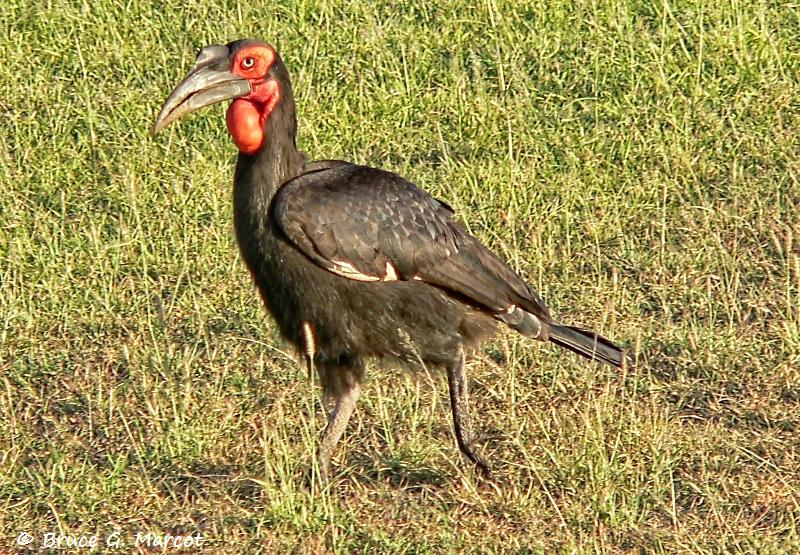
|
|
Southern Ground Hornbill Lore |
|
|
Click on images for larger versions
|
Southern Ground Hornbill (Bucorvus
leadbeateri [cafer]), Family Bucerotidae |
Credit & Copyright: Dr. Bruce G. Marcot
Explanation: Treking the savanna of Masai Mara in southern Kenya is this most massive of all the hornbills: the Southern Ground Hornbill.
The bird is so-named, as it is distributed through much of southern Africa, but also ranges into east central Africa ... and it is "grounded" in that it is mostly terrestrial, whereas many other hornbill species take to roosting or nesting in trees.
In Kenya, we were "advised" by our wonderful local guide to not speak its name, as that would confer ill fortune. Oops, too late here ...
Listed as vulnerable by IUCN, the southern ... um, this bird ... is threatened by habitat conversion and persecution, although some local tribes may still protect it through lore of its spiritual power.
In Zimbabwe, the bird is occasionally used in traditional medicine (Bruyns et al. 2012, Williams et al. 2014) and as a traditional weather indicator to forecast the start of the rainy season (Okonya and Kroschel 2013).
Mostly, local tribal beliefs have led to its protection and taboo against killing, although such protections are weakening (Trail 2007). The species' savanna habitat is being converted more and more to agriculture.
Not often seen flying, the Southern Ground Hornbill
takes to short hops close to the ground.
Information:
Bruyns, R.K., V.L. Williams, and A.B. Cunningham. 2012. Finely ground-hornbill: the sale of Bucorvus cafer in a traditional medicine market in Bulawayo, Zimbabwe. Chapter 20 (pp. 475-486) in: R.R.N. Alves and I.L. Rosa, editors. Animals in traditional folk medicine: implications for conservation. Springer. Heidelberg.
Okonya, J.S., and J. Kroschel. 2013. Indigenous knowledge of seasonal weather forecasting: a case study in six regions of Uganda. Agricultural Sciences 4(12):641-648.
Trail, P.W. 2007. African hornbills: keystone species threatened by habitat loss, hunting and international trade. Ostrich 78(3):609-613.
Williams, V.L., A.B. Cunningham, A.C. Kemp, and R.K. Bruyns. 2014. Risks to birds traded for African traditional medicine: a quantitative assessment. PLOS One 9(8):e105397. doi:10.1371/journal.pone.0105397
Next week's picture:
Desert Tracks
< Previous ... | Archive |
Index |
Location | Search | About EPOW | ... Next >
|
|
Author & Webmaster: Dr.
Bruce G. Marcot
Disclaimers and Legal
Statements
Original material on Ecology Picture of the Week ©
Bruce G. Marcot
Member Theme of The Plexus